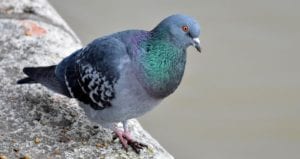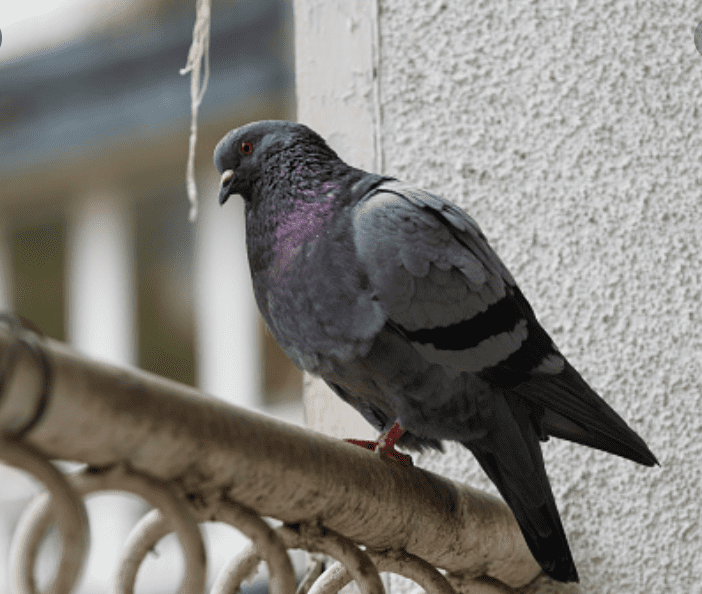
by Pigeon Patrol | Jun 14, 2023 | Bird Spike, Pigeon Droppings, Pigeon Patrol's Services, Pigeon Predators, Pigeon Spikes, Pigeons, Pigeons in the News
For half a century after WWII ended, the Swiss army refused to decommission its carrier pigeons, even though they had long outlived their usefulness.
Certain species of pigeons have an uncanny ability to find their way home to their coops from any distance. That is why pigeons were widely used to carry messages from one military unit to another in World War I and II.
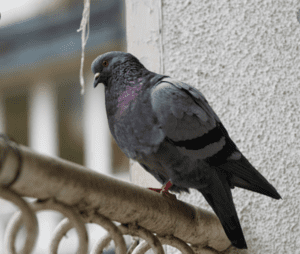
But only the Swiss army had kept its pigeons long after the war ended — until 1996. They have been on standby for decades in case of invasion— this time from the Soviet Union.
The birds “have been specially trained for homing and are used to flying long distances over all kinds of terrain,” Samuel Iselin, a spokesman for the Federal Office of Signal Troops in Bern, said just before the pigeon troops were disbanded.
But since the country had not been involved in either of the world wars, it is safe to assume that Swiss pigeons had never seen active combat duty or witnessed any frontline action.
There is also no record of any of them falling victim to enemy fire, unlike their French counterpart, Cher Ami, which was hit while delivering messages during the Battle of Verdun in 1916. She was awarded the posthumous Croix de Guerre medal for her bravery.
It is perhaps natural to think that pigeons carried messages in their beaks, like the olive branches. But in fact, messages were written on light paper, rolled into a small tube, and attached to the bird’s leg.
From 1919 until 1996, Switzerland owned 7,000 pigeons; another 23,000 were on standby to use in case of national emergency.
In the early 1990s, the Defense Ministry decided to save $476,000 a year by finally retiring the flock and focusing on more modern communication methods.
But in a truly Swiss fashion, a pro-pigeon group had collected 100,000 signatures for a referendum to enshrine the carrier pigeon service in the Swiss constitution.
In the end, however, bird enthusiasts and the army reached a compromise: a new foundation was established especially to care for the retired military pigeons in their new civilian life.
Thirty elite birds were pigeonholed, as it were, to live out their retirement in warmer climes.
They were sold to a private South African buyer, and they didn’t even have to fly to their new home themselves. “The pigeons were handed over in Zurich and put aboard a South African Airways flight,” Iselin explained.
Source
Pigeon Patrol Products & Services is the leading manufacturer and distributor or bird deterrent (control) products in Canada. Pigeon Patrol products have solved pest bird problems in industrial, commercial, and residential settings since 2000, by using safe and humane bird
deterrents with only bird and animal friendly solutions. At Pigeon Patrol, we manufacture and offer a variety of bird deterrents, ranging from Ultra-flex Bird Spikes with UV protection, Bird Netting, 4-S Bird Gel and the best Ultrasonic and audible sound devices on the market today.
Voted Best Canadian wholesaler for Bird Deterrent products ten years in a row.
Contact us at 1 877-4-NO-BIRD,(604) 585-9279 or visit our website at www.pigeonpatrol.ca
Pigeon/Pigeon Patrol / Pigeons Roosing / Vancouver Pigeon Control / Bird Spikes / Bird Control / Bird Deterrent / PIgeon Deterrent / Surrey Pigeon Control / Pest / Seagull deterrent / Vancouver Pigeon Blog / Birds Inside Home / Pigeons in the cities / Ice Pigeons / What to do about pigeons / sparrows, Damage by Sparrows, How to Keep Raccoons Away, Why Are Raccoons Considered Pests / De-fence / Pigeon Nesting / Bird Droppings / Pigeon Dropping / woodpecker control / Professional Bird Control Company / Keep The Birds Away / Birds/rats/seagull/pigeon/woodpecker/dove/sparrow/pidgeon control/pidgeon problem/pidgeon control/flying rats/pigeon problems/ bird netting/bird gel/bird spray/bird nails/bird guard
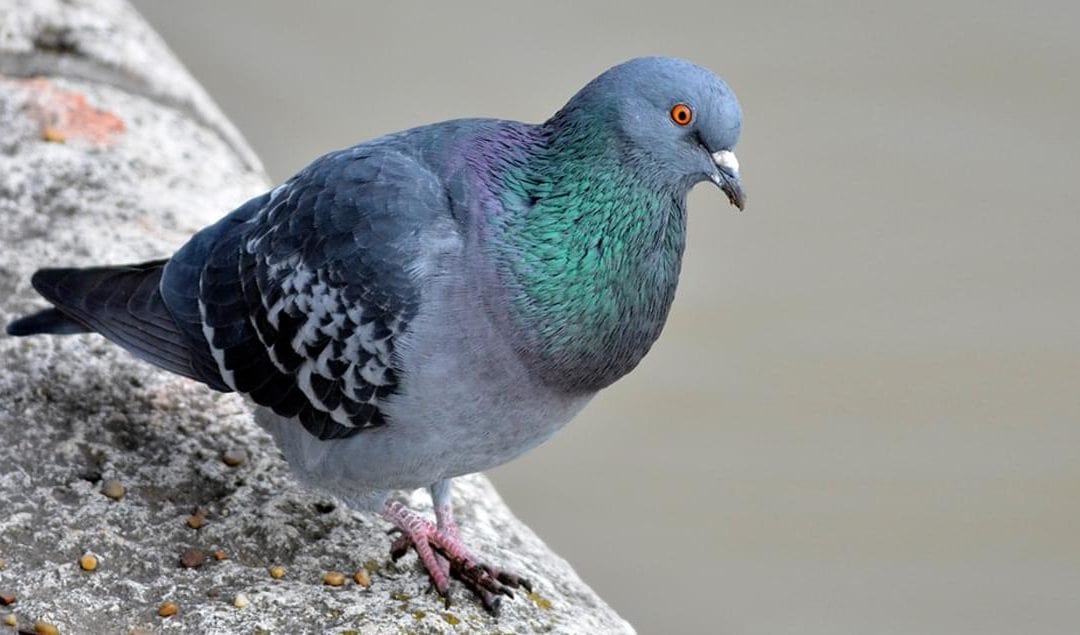
by Pigeon Patrol | Jun 14, 2023 | history of pigeons, MBCA, pet bird, Pigeon Control, Pigeon Droppings, Pigeon Patrol's Services, Pigeon Predators
A team of researchers from the University of London and Monash University has found that pigeon pecking order is driven by weight and that a given pecking order can be artificially changed. In their paper published in the journal Biology Letters, the group describes their study of the pecking order of domesticated pigeons and what they learned about them.
The term pecking order has come to be used as a way to describe the hierarchy that exists within a group of animals, including humans. Typically, those at the top of the hierarchy have better access to food or a mate, while those at the bottom must scramble to get by. In this new effort, the researchers looked at pecking order in pigeons at the Royal Veterinary College of the University of London. The pigeons housed there are used for homing purposes—nine are female and eight are male. They are all six years old and differ slightly in size. Over the course of the three-year study, the birds were given access to food and water and no other birds were included as part of the group. The group was closely watched for a period of time at three points during their annual cycle. Also, at 19 months into the study, the researchers affixed small weights to the smallest of the pigeons.
In studying the birds, the researchers found that they had a clear hierarchy, with the larger birds at the top and the smaller birds at the bottom. Those at the top of the hierarchy were first in line when food and water were given, while those lower down had to settle for less food by the time their turn came. The researchers found that the larger birds were more aggressive, which is why they got their way when feeding. Things changed dramatically, however, when the researchers added the weights to the smallest birds. With the increase in weight, the birds grew more aggressive and very quickly moved up the hierarchy, eventually arriving at the top. And they remained at the top of the hierarchy until the researchers removed the weights. At their suddenly reduced weight, the birds lost their aggressiveness and slid down to the bottom of the hierarchy once again.
The researchers note that their study shows that aggressive traits in an animal can be modified simply by changing a physical attribute such as weight. They suggest their findings indicate that people feeding bread crumbs to birds at a park may be making them more aggressive.
Source
Pigeon Patrol Products & Services is the leading manufacturer and distributor or bird deterrent (control) products in Canada. Pigeon Patrol products have solved pest bird problems in industrial, commercial, and residential settings since 2000, by using safe and humane bird
deterrents with only bird and animal friendly solutions. At Pigeon Patrol, we manufacture and offer a variety of bird deterrents, ranging from Ultra-flex Bird Spikes with UV protection, Bird Netting, 4-S Bird Gel and the best Ultrasonic and audible sound devices on the market today.
Voted Best Canadian wholesaler for Bird Deterrent products ten years in a row.
Contact us at 1 877-4-NO-BIRD,(604) 585-9279 or visit our website at www.pigeonpatrol.ca
Pigeon/Pigeon Patrol / Pigeons Roosing / Vancouver Pigeon Control / Bird Spikes / Bird Control / Bird Deterrent / PIgeon Deterrent / Surrey Pigeon Control / Pest / Seagull deterrent / Vancouver Pigeon Blog / Birds Inside Home / Pigeons in the cities / Ice Pigeons / What to do about pigeons / sparrows, Damage by Sparrows, How to Keep Raccoons Away, Why Are Raccoons Considered Pests / De-fence / Pigeon Nesting / Bird Droppings / Pigeon Dropping / woodpecker control / Professional Bird Control Company / Keep The Birds Away / Birds/rats/seagull/pigeon/woodpecker/dove/sparrow/pidgeon control/pidgeon problem/pidgeon control/flying rats/pigeon problems/ bird netting/bird gel/bird spray/bird nails/bird guard
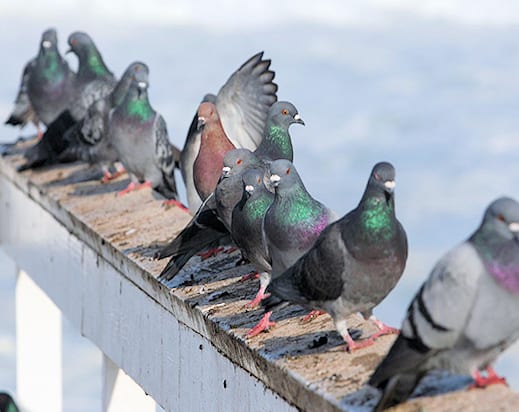
by Pigeon Patrol | May 30, 2023 | history of pigeons, MBCA, pet bird, Pigeon Control, Pigeon Droppings, Pigeon Patrol's Services, Pigeon Predators
A young woman in Fredericton is singing on the street to call attention to the disease that made her blind.
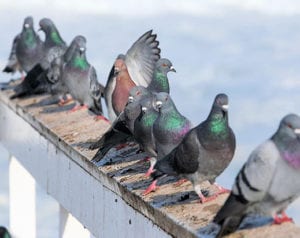
Erica Richards lost her sight last year after developing Cryptococcus meningitis.
Cryptococcus meningitis is a potentially fatal swelling of the membranes surrounding the brain. The disease is caused by fungus that lives in the guts of pigeons and other birds, such as chickens.
People can breathe it in if they’re exposed to pigeon droppings.
The 24-year-old was living in a house that had a pile of pigeon feces in the attic, and she also had a compromised immune system from chemotherapy .
“A reverse migraine — I needed light, I needed sound. I needed neck massages. Couldn’t lay down, couldn’t sit up. Couldn’t eat. I was vomiting. And then I started having double vision, quadruple vision, then seizures. And then I ended up in hospital,” she said as she described her symptoms.
Richards sings to supplement her $135 a month disability payment.
Kevin Forward is an infectious disease specialist who teaches at Dalhousie Medical School in Halifax.
“I think it’s pretty common sense. Move to avoid being in a situation where there are a lot of pigeon droppings, particularly if you’re disturbing them, cleaning them up, sweeping them,” Forward said.
“Those kind of situations should certainly be avoided. But if you’re in the park that has some pigeons around, I think the risk is infinitely small.”
Pigeons are part of the urban landscape, but they are known to carry a long list of disease-causing organisms — such as Chlamydia and salmonella.
That, along with complaints about them damaging roofs, led Fredericton to add pigeons to the city’s animal control bylaw last year.
Property owners are now prohibited from spreading feed or anything else that would attract pigeons.
Richards wants to make sure people know the risk of coming into contact with pigeon feces.
“To draw attention, to raise awareness so people will ask questions, so they will know what the symptoms are,” Richards said. “So that way, they can be warned ahead of time, before what happened to me happens to them.”
Next month, she’ll be going to a school sponsored by the Canadian National Institute for the Blind to finish high school and to get matched with a seeing-eye dog.
She hopes to go on to study law.
Source
Pigeon Patrol Products & Services is the leading manufacturer and distributor or bird deterrent (control) products in Canada. Pigeon Patrol products have solved pest bird problems in industrial, commercial, and residential settings since 2000, by using safe and humane bird
deterrents with only bird and animal friendly solutions. At Pigeon Patrol, we manufacture and offer a variety of bird deterrents, ranging from Ultra-flex Bird Spikes with UV protection, Bird Netting, 4-S Bird Gel and the best Ultrasonic and audible sound devices on the market today.
Voted Best Canadian wholesaler for Bird Deterrent products ten years in a row.
Contact us at 1 877-4-NO-BIRD,(604) 585-9279 or visit our website at www.pigeonpatrol.ca
Pigeon/Pigeon Patrol / Pigeons Roosing / Vancouver Pigeon Control / Bird Spikes / Bird Control / Bird Deterrent / PIgeon Deterrent / Surrey Pigeon Control / Pest / Seagull deterrent / Vancouver Pigeon Blog / Birds Inside Home / Pigeons in the cities / Ice Pigeons / What to do about pigeons / sparrows, Damage by Sparrows, How to Keep Raccoons Away, Why Are Raccoons Considered Pests / De-fence / Pigeon Nesting / Bird Droppings / Pigeon Dropping / woodpecker control / Professional Bird Control Company / Keep The Birds Away / Birds/rats/seagull/pigeon/woodpecker/dove/sparrow/pidgeon control/pidgeon problem/pidgeon control/flying rats/pigeon problems/ bird netting/bird gel/bird spray/bird nails/bird guard
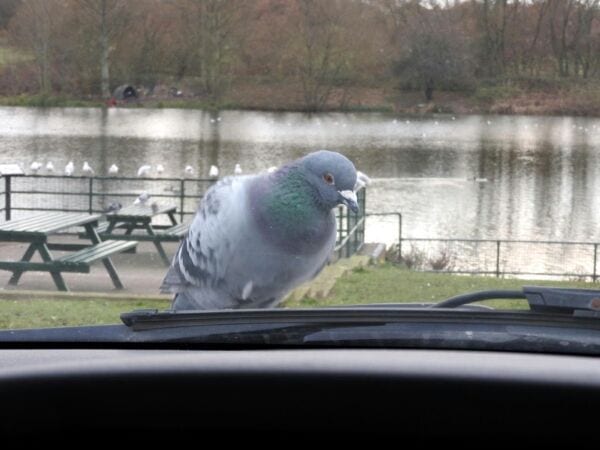
by Pigeon Patrol | May 30, 2023 | history of pigeons, MBCA, pet bird, Pigeon Control, Pigeon Droppings, Pigeon Patrol's Services, Pigeon Predators
In the span of a few weeks, Erica Richards has been transformed from a vibrant 23-year-old woman who loved nature to a person battling for her life.
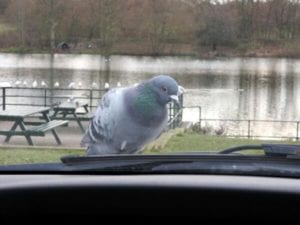
In early January, the Fredericton woman contracted a potentially fatal condition called cryptococcal meningitis, a fungal disease carried in the feces of pigeons.
The debilitating illness attacks the spine and brain, causing severe swelling. It left her confined to a hospital bed in a state of delirium for weeks.
But the most devastating side effect is that Ms. Richards is now blind.
“Be aware of this disease. It could kill a child in a heartbeat,” Ms. Richards said in an interview from her hospital bed.
“It could kill a senior in a heartbeat without you even having to worry about the symptoms. It comes on that fast. If you don’t realize the symptoms, it could kill you, too.”
Her emotional warning comes on the heels of city council’s approval earlier this month of a recommendation that it toughen its animal control bylaw to allow for fines for feeding pigeons. Once the amendment is drafted and declared law, it will give the city’s bylaw enforcement officers the power to ticket and fine offenders.
Ms. Richards said she decided to go public about her illness after learning about a recent newspaper story about a problem with pigeon poop in the city.
“Please don’t feed the pigeons,” she said. “Try to shoo them away if you see them. … It (the disease) is horrible. The pain that you get from this disease is crippling.
“The after-effects are with you for life and you just can’t stop thinking about it. I just want other people to know and try to stay away from pigeons.”
Oddly enough, Ms. Richards said she has no recollection of ever being anywhere near pigeons.
“I am still wondering to this day where I got it,” she said. “I could have stepped in it and brought it into the home. I just don’t know.”
Ms. Richards said the symptoms started with a migraine headache that wouldn’t go away. She was admitted to hospital on Feb. 10 after many days of intense head pain. Shortly after, she went into a coma-like state.
“When I woke up I thought I had a mask over my eyes, but I was wrong. I was blind. I was recently told that I will be blind for the rest of my life. This is a tough thing for a 23-year-old to go through. … My world crumbled around me.”
Ms. Richards said the odds of surviving the disease are 50-50.
“However, I managed to make it through,” she said, battling tears. “I don’t know how but I am still here, and I am glad because I get to warn everyone else of this.”
Cristin Muecke, the Health Department’s regional medical officer, confirmed the disease is often associated with pigeon droppings. She said the illness can’t be spread person to person and is more common with someone who has immune problems.
Ms. Richards, however, said she has never had a problem with her immune system and that’s what’s so puzzling about contracting the affliction.
“I do not want anyone else to suffer this agonizing disease and I ask anyone who is feeding pigeons to stop,” she said. “It’s not just a matter of keeping your neighbourhood clean … it’s a matter of keeping people healthy.”
Source
Pigeon Patrol Products & Services is the leading manufacturer and distributor or bird deterrent (control) products in Canada. Pigeon Patrol products have solved pest bird problems in industrial, commercial, and residential settings since 2000, by using safe and humane bird
deterrents with only bird and animal friendly solutions. At Pigeon Patrol, we manufacture and offer a variety of bird deterrents, ranging from Ultra-flex Bird Spikes with UV protection, Bird Netting, 4-S Bird Gel and the best Ultrasonic and audible sound devices on the market today.
Voted Best Canadian wholesaler for Bird Deterrent products ten years in a row.
Contact us at 1 877-4-NO-BIRD,(604) 585-9279 or visit our website at www.pigeonpatrol.ca
Pigeon/Pigeon Patrol / Pigeons Roosing / Vancouver Pigeon Control / Bird Spikes / Bird Control / Bird Deterrent / PIgeon Deterrent / Surrey Pigeon Control / Pest / Seagull deterrent / Vancouver Pigeon Blog / Birds Inside Home / Pigeons in the cities / Ice Pigeons / What to do about pigeons / sparrows, Damage by Sparrows, How to Keep Raccoons Away, Why Are Raccoons Considered Pests / De-fence / Pigeon Nesting / Bird Droppings / Pigeon Dropping / woodpecker control / Professional Bird Control Company / Keep The Birds Away / Birds/rats/seagull/pigeon/woodpecker/dove/sparrow/pidgeon control/pidgeon problem/pidgeon control/flying rats/pigeon problems/ bird netting/bird gel/bird spray/bird nails/bird guard

by Pigeon Patrol | May 30, 2023 | Bird Spike, Pigeon Droppings, Pigeon Patrol's Services, Pigeon Predators, Pigeon Spikes, Pigeons, Pigeons in the News
Some people enjoy spending time around pigeons in parks or sidewalks and feeding them seeds or bread crumbs, while others see pigeons as pests that harbor dangerous diseases. No matter whether you love pigeons or hate them, they do spread diseases that can infect humans. Psittacosis is one of these diseases. Occasionally being around pigeons is unlikely to lead to infection. But certain circumstances surrounding homes and businesses can put people at risk of becoming infected. So it’s important to learn about the symptoms and how pigeons spread psittacosis.

What Is Psittacosis?
Psittacosis is a respiratory illness that humans obtain from a type of bacteria (Chlamydia psittaci ) shed by birds. Sometimes called parrot fever or ornithosis, the disease can affect many different species of birds. Infected birds can become very sick or show no symptoms at all, making it difficult to know if surrounding people are at risk. Whether birds have symptoms or not, they can still pass the disease to people and other mammals.
Infected birds with and without symptoms shed the bacteria in respiratory secretions and droppings. When these secretions and droppings dry, they form dust that spreads through the air and can be inhaled into human respiratory systems. People get the disease by breathing in dried dust particles — that’s how pigeons spread psittacosis. However, it can be spread through bites or beak-to-mouth contact.
People of any age can contract psittacosis, but it’s most common among bird owners or people who work in bird-related occupations. However, psittacosis in pigeons can present additional points of infection. The illness has a rapid transmission rate among birds and thrives in overcrowded areas, like roosting spaces and nests. So it’s likely that massive flock outbreaks occur among pigeons.
Psittacosis Symptoms
Most often, psittacosis symptoms are similar to flu symptoms. However, symptoms can become severe and include pneumonia. If you suspect you’ve been infected with psittacosis, it’s necessary to seek medical attention since antibiotic treatment is required. Symptoms may include:
- • Dry cough
- • Fever
- • Chills
- • Headache
- • Muscle aches
- • Nausea/vomiting
- • Sore throat
- • Difficulty breathing in severe cases
- • Chest pain in severe cases
- • Pneumonia in severe cases
- • Nosebleeds in severe cases
- • Swelling of organs in severe cases
Treatment
Psittacosis is considered rare in humans since only 50 to 200 cases each year are reported. However, many researchers think the illness is under-reported; the symptoms mimic common illnesses like the flu, and the point of infection often goes unnoticed. Severe cases of psittacosis require medical treatment for recovery. Antibiotic therapy is the primary treatment for individuals with psittacosis (typically tetracycline or doxycycline).
How Pigeons Spread Psittacosis
While people also call psittacosis ‘parrot disease,’ any bird susceptible to the bacteria can spread infection. Since pigeons travel and roost in large flocks, it’s likely that the disease spreads readily among pigeons in crowded areas. Sick birds can exhibit symptoms like red, watery eyes, nasal discharge, lethargy, ruffled feathers, diarrhea, and a poor appetite. Alternatively, they can exhibit no symptoms at all. It’s suspected that pigeons have genetic resistance that makes them more likely to show no symptoms and, consequently, become carriers.
In many cities, workspaces, and areas around homes, pigeons roost in large groups and leave piles of feces that must be cleaned away regularly. These areas create potential infection points for people. Once you know how pigeons spread psittacosis, you can focus on maintenance tasks that minimize the risks.
Psittacosis Dangers for Homeowners
Pigeons are common in both urban and rural areas. Unfortunately, when they decide to infest the space around your home, you might find them roosting over your patio, on your children’s play equipment, or even in your attic. If you have pigeons roosting around your home, they leave piles of droppings anywhere they flock. After what you’ve learned about how pigeons spread psittacosis, imagine sweeping piles of dried droppings from your patio — or worse, your attic. When pigeons spend their nights or evenings on playhouses or swing sets, they put your children at risk of getting psittacosis when they go outside to play.
Short of avoiding the spaces you enjoy outdoors, it’s nearly impossible to completely eliminate the risk of psittacoses exposure when you have a pigeon infestation. The solution is deterrence. Visual bird deterrents include lights, holographic devices, and decoy owls or other decoy predators that can be used to frighten pigeons away from your home and yard. Audio bird deterrents work best for residences without pets. They use distress calls and frightening noise to scare birds away.
Psittacosis in Commercial Settings
Commercial properties are even more likely than homes to attract flocking pigeons. If you’ve dealt with pigeons at your business property, you know all the spaces where they leave piles of droppings (and the damage they can cause). As a business owner, you know bird droppings and the health risks of psittacosis present a variety of worries. Droppings on storefronts, trash cans, streetlights, sidewalks, parking lots, railings, and any of the other places pigeons roost have the potential to endanger your customers and employees, as well as your own health. Even worse, when pigeons get inside your commercial building, they can pose additional threats by accessing your storage.
As a business owner, you have a responsibility to keep your landscape and business clean. But cleaning away bird droppings can present risks. OSHA recommends precautions to protect workers from contracting the disease through inhalation. However, deterrence can help you avoid all the problems associated with pigeons and their effect on commercial spaces. While visual and audio deterrents are useful in commercial settings, other measures might also be required. Bird spikes and optical gel are both popular solutions for deterring pigeons in commercial spaces.
Learning about how pigeons spread psittacosis and the dangers caused by pigeon droppings can help you understand the disease’s symptoms and ways you can avoid infection. Safely and humanely deterring pigeon flocks is the best way to avoid dangers from their droppings and the damage they cause around your home or business. To learn more about psittacosis and other diseases that can be spread in pigeon droppings, get in touch with our bird control experts.
Source
Pigeon Patrol Products & Services is the leading manufacturer and distributor or bird deterrent (control) products in Canada. Pigeon Patrol products have solved pest bird problems in industrial, commercial, and residential settings since 2000, by using safe and humane bird
deterrents with only bird and animal friendly solutions. At Pigeon Patrol, we manufacture and offer a variety of bird deterrents, ranging from Ultra-flex Bird Spikes with UV protection, Bird Netting, 4-S Bird Gel and the best Ultrasonic and audible sound devices on the market today.
Voted Best Canadian wholesaler for Bird Deterrent products ten years in a row.
Contact us at 1 877-4-NO-BIRD,(604) 585-9279 or visit our website at www.pigeonpatrol.ca
Pigeon/Pigeon Patrol / Pigeons Roosing / Vancouver Pigeon Control / Bird Spikes / Bird Control / Bird Deterrent / PIgeon Deterrent / Surrey Pigeon Control / Pest / Seagull deterrent / Vancouver Pigeon Blog / Birds Inside Home / Pigeons in the cities / Ice Pigeons / What to do about pigeons / sparrows, Damage by Sparrows, How to Keep Raccoons Away, Why Are Raccoons Considered Pests / De-fence / Pigeon Nesting / Bird Droppings / Pigeon Dropping / woodpecker control / Professional Bird Control Company / Keep The Birds Away / Birds/rats/seagull/pigeon/woodpecker/dove/sparrow/pidgeon control/pidgeon problem/pidgeon control/flying rats/pigeon problems/ bird netting/bird gel/bird spray/bird nails/bird guard
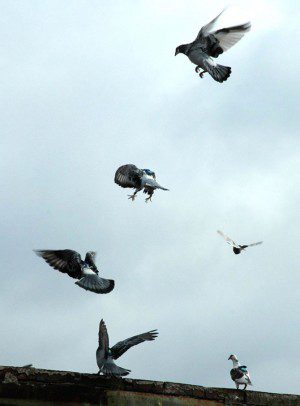
by Pigeon Patrol | May 23, 2023 | Bird Spike, Pigeon Droppings, Pigeon Patrol's Services, Pigeon Predators, Pigeon Spikes, Pigeons, Pigeons in the News
Pigeons are always on the lookout for a source of food and buildings with plenty of high nooks and crannies to roost and nest in, and your factory might just fit the bill.
But if pigeons get into your factory, it’s a serious problem. These pest birds and their guano (poo) carry and spread some nasty diseases, and they can also damage property. This is bad news for any business, but if food is manufactured, packaged, and stored in your factory, it can be disastrous.
Before your reputation and your profits take a serious hit, read our advice on how you can keep pigeons out of your factory.
How to prevent pigeons from getting into your factory
First, eliminate any sources of food
Any sources of food will be very attractive to pigeons, and eliminating them will make your factory less desirable to roost or nest in. Keep your factory scrupulously clean and don’t leave food ingredients or waste lying around, inside or outside of the premises.
It’s also a good idea to talk to nearby businesses if their poor waste management or housekeeping practices are attracting pest birds to the vicinity.
Second, use deterrents
When you are trying to prevent pigeons from nesting or roosting in or on your property, deterrents like bird spikes, bird wire, and netting can be effective at keeping them at bay.
Third, fix up your factory
If there are holes in your factory roof or walls that you haven’t got around to fixing, you could inadvertently be providing pigeons with the perfect nesting place. Make sure you fix them up-deterring pigeons is all about making your factory much less attractive to them.
Finally, deal with the guano
As we mentioned earlier, pigeon droppings can contain some harmful bacteria, so we would recommend that you don’t try to clean it up yourself.
If pest pigeons have made a mess of your factory, call in the professionals. We will blast away guano with the right equipment and products so your premises is clean, safe, and hygienic again.
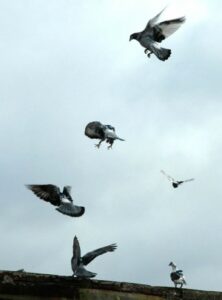
Do I need professional pigeon control for my factory?
As birds are protected by the Wildlife and Countryside Act 1981, it’s illegal to poison or shoot them if you don’t have a license. If you put poison down, you could harm other birds and end up in legal trouble. And not only that, if you’re a food business, you won’t be able to use toxic bird control methods anyway as you could contaminate your product.
If you hire professional pest control, you can get your pest problem dealt with fast. We can deal with any existing infestation, install effective bird-proofing and deterrents, and give you expert advice on preventing any problems in the future.
Source
Pigeon Patrol Products & Services is the leading manufacturer and distributor or bird deterrent (control) products in Canada. Pigeon Patrol products have solved pest bird problems in industrial, commercial, and residential settings since 2000, by using safe and humane bird
deterrents with only bird and animal friendly solutions. At Pigeon Patrol, we manufacture and offer a variety of bird deterrents, ranging from Ultra-flex Bird Spikes with UV protection, Bird Netting, 4-S Bird Gel and the best Ultrasonic and audible sound devices on the market today.
Voted Best Canadian wholesaler for Bird Deterrent products ten years in a row.
Contact us at 1 877-4-NO-BIRD,(604) 585-9279 or visit our website at www.pigeonpatrol.ca
Pigeon/Pigeon Patrol / Pigeons Roosing / Vancouver Pigeon Control / Bird Spikes / Bird Control / Bird Deterrent / PIgeon Deterrent / Surrey Pigeon Control / Pest / Seagull deterrent / Vancouver Pigeon Blog / Birds Inside Home / Pigeons in the cities / Ice Pigeons / What to do about pigeons / sparrows, Damage by Sparrows, How to Keep Raccoons Away, Why Are Raccoons Considered Pests / De-fence / Pigeon Nesting / Bird Droppings / Pigeon Dropping / woodpecker control / Professional Bird Control Company / Keep The Birds Away / Birds/rats/seagull/pigeon/woodpecker/dove/sparrow/pidgeon control/pidgeon problem/pidgeon control/flying rats/pigeon problems/ bird netting/bird gel/bird spray/bird nails/bird guard




